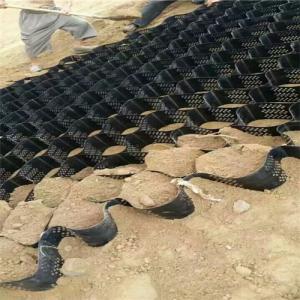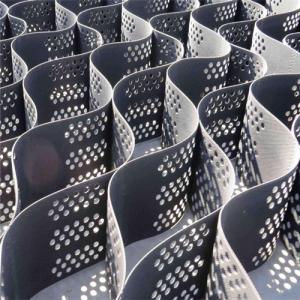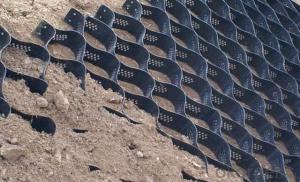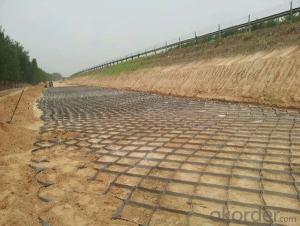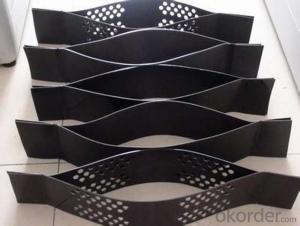HDPE Geocell for Road Reinforcement with Different Welding Distance
- Loading Port:
- China main port
- Payment Terms:
- TT or LC
- Min Order Qty:
- 10000 m²
- Supply Capability:
- 5000000 m²/month
OKorder Service Pledge
OKorder Financial Service
You Might Also Like
Geocell Description
Geocell is high-molecular polymer, connected by rivets or ultrasonic welded to three-dimensional network structure, unfold it and fill in sand, gravel and clay, etc. when used at construction site.
According to customer’s requirement, cut holes or carve arabesquitic in order to increase its lateral permeable ability, also increase the friction and binding force with the foundation material.

Geocell Specification
Welding distance:330-1000mm
Height:50-250mm
Surface: Textured or Smooth
Color: black,brown,green
Geocell Property:
1) Retractile, foldable when transportation, pulled to net work when construction, fill in the soil, gravel, concrete, atc. Loose materials,
form one structure with strong lateral limitations and high stiffness.
2) Material is light, abrasion resistance, chemical properties stable, resist photooxidation aging, acid and alkali resistant, suitable for different soil and soil conditions, such as desert.
3) Good lateral restrict and prevent slippery, prevent deformation, effectively enhance the bearing capacity of subgrade and dispersed
loads function.
4) The geocell height and welding distance etc. geometric dimensions are all changeable in order to meet the requirement of different projects.
5) Capable and easily be expanded or contracted, small size for transportation, easy for connect and construction speed is fast.
Geocell Application
1) Used for the stability of railway road.
2) To stabilize the desert highway road.
3) Used in the governance of shallow water channel.
4) Used for the foundation reinforcement of retaining wall, wharf, levee.
5) For the management of desert, beaches and river banks
- Q: Can geocells be used in underground drainage systems?
- Yes, geocells can be used in underground drainage systems. Geocells are often used to provide structural support and stability in various civil engineering applications, including underground drainage systems. They help to prevent soil erosion, enhance water flow, and improve overall drainage performance. By confining and reinforcing the surrounding soil, geocells can effectively enhance the durability and efficiency of underground drainage systems.
- Q: How do geocells improve soil compaction?
- Geocells improve soil compaction by confining the soil particles within their cell walls, preventing lateral movement and increasing vertical load distribution. Additionally, the cells' interlocking mechanism enhances soil stabilization, reducing settlement and improving overall compaction.
- Q: Can geocells be used in landfill construction?
- Yes, geocells can be used in landfill construction. Geocells are often used as a cost-effective solution for soil stabilization and erosion control in various applications, including landfills. They provide structural support and enhance the stability of the landfill structure, preventing soil erosion and promoting efficient waste containment. Additionally, geocells can help distribute the load evenly, reducing settlement and prolonging the lifespan of the landfill.
- Q: Can geocells be used for airport runway construction?
- Yes, geocells can be used for airport runway construction. Geocells provide excellent support and reinforcement to the runway base, reducing soil erosion and improving load-bearing capacity. They are also cost-effective and easy to install, making them a viable option for runway construction projects.
- Q: Can geocells be used in both temporary and permanent applications?
- Yes, geocells can be used in both temporary and permanent applications. Geocells are versatile and durable, making them suitable for a wide range of applications including soil stabilization, erosion control, and reinforcement of weak soils. Whether it is for temporary construction sites or long-term infrastructure projects, geocells provide an effective and cost-efficient solution.
- Q: Can geocells be used for revetment applications?
- Yes, geocells can be used for revetment applications. Geocells are three-dimensional honeycomb-like structures made from high-density polyethylene (HDPE) or other materials. They are filled with soil, aggregate, or concrete and used to stabilize slopes, prevent erosion, and provide structural support in various civil engineering projects. In revetment applications, geocells can be placed along shorelines, riverbanks, or embankments to prevent soil erosion and protect against wave action. They enhance the stability and longevity of the revetment structure while allowing for vegetation growth, making them an effective and environmentally friendly solution.
- Q: Can geocells be used in retaining wall reinforcement?
- Yes, geocells can be used in retaining wall reinforcement. Geocells are three-dimensional honeycomb-like structures made from high-density polyethylene (HDPE) that can be filled with soil or aggregate. When used in retaining wall construction, geocells provide additional stability and reinforcement by confining the backfill material and preventing lateral movement. This helps to increase the overall strength and load-bearing capacity of the retaining wall while also reducing the risk of soil erosion and slope failure.
- Q: Can geocells be used for wastewater treatment?
- No, geocells are not typically used for wastewater treatment. They are primarily used for soil stabilization and erosion control in civil engineering projects. Wastewater treatment involves a different set of technologies and processes.
- Q: Can geocells be used in wetland restoration?
- Yes, geocells can be used in wetland restoration. Geocells are cellular confinement systems made of interconnected cells that can be filled with soil, gravel, or other materials. They provide stability and reinforcement to the soil, helping to prevent erosion and promote vegetation growth. In wetland restoration projects, geocells can be used to create stable platforms for planting vegetation, building trails or walkways, or creating habitat features. They can also help to control water flow and prevent soil erosion, which is crucial in wetland environments. Overall, geocells can be an effective and sustainable solution for wetland restoration efforts.
- Q: How do geocells enhance pavement performance?
- Geocells enhance pavement performance by providing a stable and reinforced base for the pavement structure. They confine and reinforce the filling material, such as aggregate or soil, preventing lateral spreading and improving load distribution. This helps to reduce surface deformations, minimize rutting and cracking, and increase the overall durability and lifespan of the pavement.
Send your message to us
HDPE Geocell for Road Reinforcement with Different Welding Distance
- Loading Port:
- China main port
- Payment Terms:
- TT or LC
- Min Order Qty:
- 10000 m²
- Supply Capability:
- 5000000 m²/month
OKorder Service Pledge
OKorder Financial Service
Similar products
Hot products
Hot Searches
Related keywords
